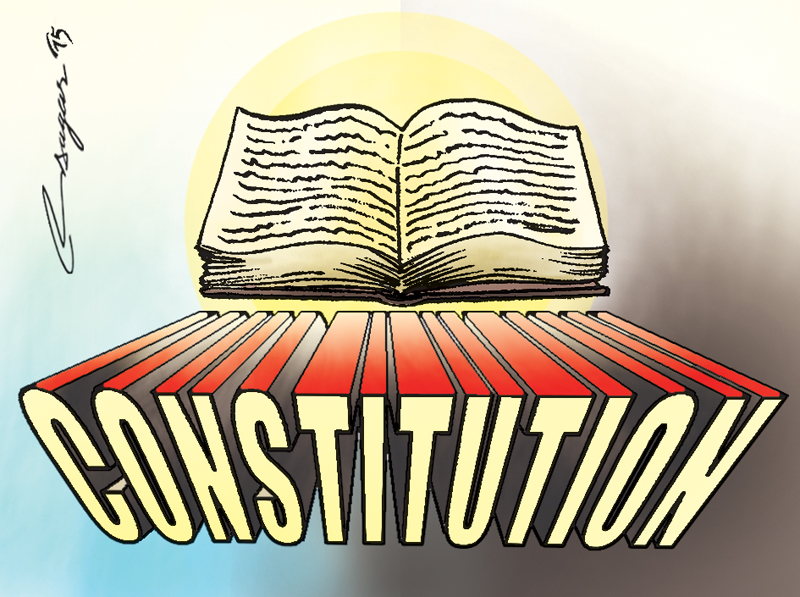Constitution promulgation
In a democracy, dialogue is a natural process to sort out issues and this process should be emphasized with sincerity. If there are any reasonable demands unaddressed, there should be no hesitation in addressing them
The Constitution of Nepal-2015 has arrived at long last, promulgated yesterday with immediate effect, replacing the Interim Constitution, 2007. The new constitution also formally brings to a conclusion of the Comprehensive Peace Agreement, by fulfilling the last piece of the agreement that had been signed between the State and the then rebel Maoists, who had started armed rebellion 20 years ago. What is of no less importance is that it has ended the long cycle of events set in motion by the 12-point understanding signed in New Delhi by the seven political parties, including the Nepali Congress, the CPN-UML, and the present UCPN-Maoist. This constitution has also ended the long political transition full of uncertainties and doubts and pressing of numerous reasonable and unreasonable demands, often accompanied with threats by all and sundry.
All this had made the Nepali people want the promulgation of the constitution even more intensely. That is why the people have, by and large, greeted the new constitution with jubilation. Indeed, it should be welcomed despite the fact that it has several faults, including serious ones, as well as the way in which some things were inserted and some others were excluded, which cannot be said to truly reflect the minds of (the overwhelming) majority of the Nepali people. The four big parties that inked the 16-point agreement post-earthquake to seriously set about the task of finalizing the constitution deserve appreciation. They have finally delivered.
There are quite a few people who say that the constitution, by trying to incorporate the demands of numerous groups and appease all, has become something of a “camel” in the end, an ugly animal. There is some element of truth to it. But after making many mistakes in the years past and opening Pandora’s box, the leaders of the three big parties did not seem to have much choice in the final stages. This constitution is indeed a document of compromise in which each of the major political parties has sacrificed some of its pet concerns in order to make constitution-making process successful. By that token, it is impossible to incorporate into the fundamental law of the land all the claims of any single group or groups.
Therefore, the decision of some of the fringe Madhes-centric parties to dissociate themselves from the constitution-writing process in its final phases is misguided, as they have missed the historic opportunity of participation in producing a constitution. Most of their demands have already been addressed, and how exactly the boundaries of the federal units should be delineated will be looked after by the federal commission to be formed for that purpose, and this issue and what powers the federal units should have are also the product of compromises, keeping in view the practicality and the long-term interests of Nepal and the Nepali people. However, any geographical delineations and the present power-sharing between the Centre and federal units are not something engraved on stone--they are subject to amendment as and when need arises. The Madhes-based parties should learn something from the RPP-N and other parties.
Withdrawing from the democratic process just because some of one’s demands have not been addressed just the way one would like them to be addressed will rather weaken one’s democratic credentials and raise serious questions of intent. In a democracy, dialogue is a natural process to sort out issues and this process should be emphasized with sincerity. If there are any reasonable demands unaddressed, there should be no hesitation in addressing them, but as regards unreasonable demands, there should be no hesitation in saying a firm no, either.
Admittedly, we cannot say that some of the most important elements of the constitution were the demands of the majority of the Nepali people; for, example, the surreptitious removal of the constitutional status of Nepal being a Hindu country and insertion of secularism instead; even the issue of federalism which had been little debated in public before it was all of a sudden, and unnaturally, brought to the fore in the Madhes agitation; and in a lesser degree; even the last-minute removal of the monarchy, which had become less much popular in the latter years, though, had something of an element of surprise.
That said, however, the constitution should be owned up by one and all. Those rejecting it will naturally be sidelined, as the vast majority of the people have already embraced it, despite the fact that many of them have reservations on its several features. As democratic practice moves ahead according to this constitution, the disgruntled groups will find themselves under strong pressure to jump on the bandwagon. It is another matter that each party may try to get its remaining priorities included in the constitution through amendments in the future.
As regards granting special rights and privileges to various communities, classes and groups, this constitution is a front-runner in the world and easily No. 1 in South Asia. Therefore, it is simply wrong to say that the constitution has not brought into its folds the maximum possible cross-sections of Nepali society. The percentage of CA members who have endorsed this constitution is unequalled in any country where the constitution was made by a CA.






